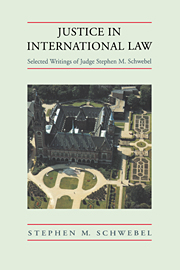Book contents
- Frontmatter
- Contents
- Preface
- PART I International Court of Justice
- 1 Reflections on the Role of the International Court of Justice
- 2 Relations Between the International Court of Justice and the United Nations
- 3 Was the Capacity to Request an Advisory Opinion Wider in the Permanent Court of International Justice than it is in the International Court of Justice?
- 4 Authorizing the Secretary-General of the United Nations to Request Advisory Opinions of the International Court of Justice
- 5 Preliminary Rulings by the International Court of Justice at the Instance of National Courts
- 6 Chambers of the International Court of Justice Formed for Particular Cases
- 7 Three Cases of Fact-Finding by the International Court of Justice
- 8 Indirect Aggression in the International Court
- 9 Human Rights in the World Court
- PART II International Arbitration
- PART III United Nations
- PART IV International Contracts and Expropriation
- PART V Aggression under, Compliance with, and Development of International Law
- List of publications
- Index
6 - Chambers of the International Court of Justice Formed for Particular Cases
Published online by Cambridge University Press: 06 November 2009
- Frontmatter
- Contents
- Preface
- PART I International Court of Justice
- 1 Reflections on the Role of the International Court of Justice
- 2 Relations Between the International Court of Justice and the United Nations
- 3 Was the Capacity to Request an Advisory Opinion Wider in the Permanent Court of International Justice than it is in the International Court of Justice?
- 4 Authorizing the Secretary-General of the United Nations to Request Advisory Opinions of the International Court of Justice
- 5 Preliminary Rulings by the International Court of Justice at the Instance of National Courts
- 6 Chambers of the International Court of Justice Formed for Particular Cases
- 7 Three Cases of Fact-Finding by the International Court of Justice
- 8 Indirect Aggression in the International Court
- 9 Human Rights in the World Court
- PART II International Arbitration
- PART III United Nations
- PART IV International Contracts and Expropriation
- PART V Aggression under, Compliance with, and Development of International Law
- List of publications
- Index
Summary
Among the many aspects of the International Court of Justice (ICJ) which have been uniquely illuminated by Shabtai Rosenne is that of the Court's formation of a chamber for dealing with a particular case, in pursuance of its authority under Article 26, paragraph 2 of its Statute. With characteristic specificity and subtlety of analysis, Rosenne's treatment brings out – or anticipates – the problems such chambers may pose and the possibilities they may offer. In this as in other of his dissections of the corpus of the Court's anatomy and jurisprudence, Rosenne has made an exceptional contribution to the understanding of how the Court works and to the prospects of its working more effectively.
This essay examines ad hoc chambers of the Court as provided for in the Court's Statute and Rules and as they have developed in practice. In the light of that exposition, it identifies what appear to be the principal questions such chambers pose, and suggests answers to those questions.
The Statute of the Permanent Court
The Statute of the Permanent Court of International Justice (PCIJ) contained detailed provisions regarding chambers for specified categories of cases. It provided that, at the request of the parties, labor cases shall be heard and determined by a special chamber of five judges appointed every three years by the Court and “selected so far as possible with due regard to the provisions of Article 9.”
- Type
- Chapter
- Information
- Justice in International LawSelected Writings, pp. 93 - 124Publisher: Cambridge University PressPrint publication year: 1994



